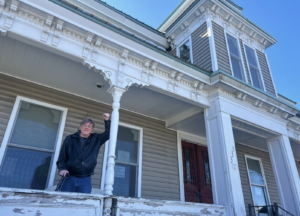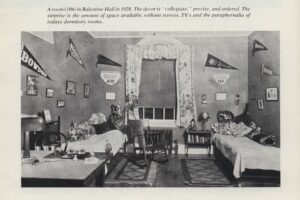While walking around the University of Maine Museum of Art (UMMA) one can expect to find the works of Jack Balas and Keliy Anderson-Staley among the four exhibitions currently on display. Through drastically different media, these artists focus on the intimacy evoked by the captured essence of mankind.
Both Balas and Anderson-Staley’s works force their audiences to look at themselves through depictions of strangers. While Anderson-Staley celebrates her subjects’ differences, Balas provokes thought through his subjects’ similarities.
Anderson-Staley, originally from Maine, is a Houston-based photographer. Her work is featured in two of the current UMMA exhibitions, entitled “Tintype Portraits” and “Traces.” By using 19th-century chemical recipes, period brass lenses and wooden view cameras, Anderson-Staley plays a key role in keeping the tintype art form alive.
Her wet plate collodion tintypes and ambrotypes are on permanent collection in the Library of Congress, Portland Museum of Art, Museum of Fine Arts-Houston and Cedar Rapids Museum of Art. Her solo exhibition, “Tintype Portraits,” is a collection of photos from her series “[Hyphen] Americans.”
Arranged on the wall like the collection of family photos hung in your grandparents’ house, “Tintype Portraits” is a collection of faces from across the nation. Highlighting people of every race, gender and background, the collection feels like a celebration of our nation’s differences and how they bring us together.
“Each individual in this series, identified only by a first name, defiantly asserts his or her selfhood, resisting any imposed or external categorizing system we might bring to these images,” Anderson-Staley said in her artist’s statement.
Anderson-Staley gives her audience the intimate experience of staring into the eyes of a stranger, while having no other influences affecting their perception. Geoffrey Batchen, an author and professor of photography history and contemporary art, articulated the power of her work in an issue of “Contact Sheet,” a catalogue of works of various artists produced by Light Work Annual, an artist-run, non-profit organization.
“Perhaps that is what is most striking about these pictures: The people portrayed still appear to be growing into them, still seem in the process of becoming themselves. In this way, Anderson-Staley’s work transcends the undoubted curiosity value of her chosen medium,” Batchen said in an artist’s statement. “Before they are tintypes, these pictures are portraits, portraits of contemporary Americans. As such, they raise the whole question of photographic portraiture, of what exactly can be deduced about an otherwise unknown person from a mere picture of his or her face.”
In the exhibition “Maine and Again,” Balas depicts a diverse collection of young men who epitomise the immortality of youth through their age, physicality and dangerously adventurous intentions.
According to the UMMA reflection on the exhibition, “These images of idealized masculinity celebrate the virility and wished-for invincibility of youth. Balas’ male subjects, at this particular stage of their lives, are full of desires, confidence, and hope. They possess an optimism and vitality as yet unfettered by the pressures of life.”
Balas uses watercolor, oil and ink to create his work. The sizes range anywhere from small compositions to multi-paneled paper pieces, as well as several larger canvases. On many of his pieces, he has scribbled notes in ink which give the audience even more insight into his thoughts and feelings during the captured moment.
“When I started painting way back in high school, it was with watercolors. I’ve always loved the transparency and working on paper, with the white shining through,” Balas said. “I’ve always loved looking at maps, and historic photos that have annotations. So treating the paintings like documents was making sense somehow, like diaries — adding a personal or historic or literary dimension.”
For the last 20 years, Balas’ work has been focused on the intimate depictions of men portrayed in “Maine and Again.” In addition to many recently completed pieces, woven through his 40 featured works, we gain insight into the adventures Balas had in Maine during the ’70s. Hidden themes of Maine landscapes, his experience meeting Andrew Wyeth, hiking to the summit of Mt. Katahdin and many other recognizable elements of Maine can be found in his pieces. As Balas reflects on his personal history, he hopes to evoke bigger thoughts from his audience. \
“I certainly want to give people something to think about, to provide images that can be thoughtful and philosophic and metaphoric, and go beyond what some might consider eye-candy. To deal with vulnerability, at the same time that these guys project attitudes of invincibly; to show intelligence when some might assign them only some meathead quotient,” Balas said. “But beyond the initial hook of unexpected male imagery, I hope everyone, men and women, can espouse some of the transcendent qualities I see in many people and try to embed in the work — things that affirm the incomprehensible beauty and wonder of life. No small task, but I love what I do.”
The exhibitions of Balas and Anderson-Staley will remain on display at the UMMA until Dec. 22. UMMA is open from Tuesday through Saturday, 10 a.m. to 5 p.m. with free admission.









